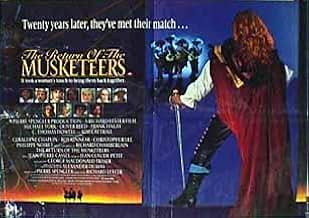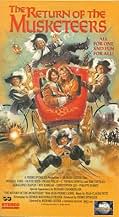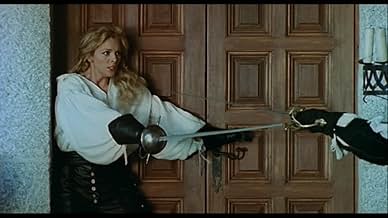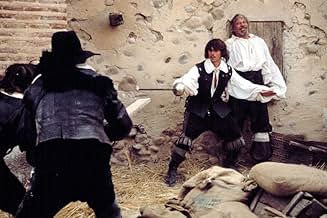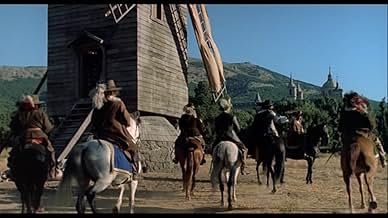NOTE IMDb
5,9/10
4,1 k
MA NOTE
Ajouter une intrigue dans votre langueIn France in 1649, the services of the Four Musketeers are needed again, and they run into some old foes from twenty years before.In France in 1649, the services of the Four Musketeers are needed again, and they run into some old foes from twenty years before.In France in 1649, the services of the Four Musketeers are needed again, and they run into some old foes from twenty years before.
- Réalisation
- Scénario
- Casting principal
Eusebio Lázaro
- Duke of Beaufort
- (as Eusebio Lazaro)
Jean-Pierre Cassel
- Cyrano de Bergerac
- (as Jean Pierre Cassel)
Avis à la une
French politics always have been a mess. The backdrop of "La Fronde" as the French civil war was known, is difficult to explain. There were no good or bad guys. The country was thrown into confusion and disarray.
The challenge of adapting the second Dumas novel (as well as the third) is that there is no clear cut plot element to hang your hat on. Unlike the race to get the jewels back from the first novel, "Twenty Years Later" is rather episodic and dis-jointed. the musketeers are no longer musketeers and (in the novel) they are not even on the same side of the political fence.
The movie tries. There is an attempt at the levity of the previous two films. The screenwriters attempt to throw in a weird romance between Athos' son Raoul and Lady De Winter's daughter (an evil son in the book). The writers also keep many of the major set pieces from the book (the fire ship plot against the heroes, the execution of Charles I, the escape of the prince of Condé, etc.) but in the end the film has no spirit.
Everyone involved must have dearly wanted to recapture the magic of the first two films. Lester was working under pressure on a television schedule and budget.
In his autobiography Michael York describes how he looked forward to the first day of shooting. The whole thing turned sour when Roy Kinnear had a tragic (and York believes, an unnecessary) accident. Kinnear was asked to ride his horse across a bridge in a long shot and tried to oblige. He fell and was rushed to the hospital where he later passed away. York feels the producers treated Kinnear and his family shabbily.
Any joy the actors may have had going in to the project evaporated after that.
The challenge of adapting the second Dumas novel (as well as the third) is that there is no clear cut plot element to hang your hat on. Unlike the race to get the jewels back from the first novel, "Twenty Years Later" is rather episodic and dis-jointed. the musketeers are no longer musketeers and (in the novel) they are not even on the same side of the political fence.
The movie tries. There is an attempt at the levity of the previous two films. The screenwriters attempt to throw in a weird romance between Athos' son Raoul and Lady De Winter's daughter (an evil son in the book). The writers also keep many of the major set pieces from the book (the fire ship plot against the heroes, the execution of Charles I, the escape of the prince of Condé, etc.) but in the end the film has no spirit.
Everyone involved must have dearly wanted to recapture the magic of the first two films. Lester was working under pressure on a television schedule and budget.
In his autobiography Michael York describes how he looked forward to the first day of shooting. The whole thing turned sour when Roy Kinnear had a tragic (and York believes, an unnecessary) accident. Kinnear was asked to ride his horse across a bridge in a long shot and tried to oblige. He fell and was rushed to the hospital where he later passed away. York feels the producers treated Kinnear and his family shabbily.
Any joy the actors may have had going in to the project evaporated after that.
A great hoax circulates about this movie. Unfortunately, we are at a time when there are no principles and the websites copy here and there, without more, without citing provenance, including the supposedly serious ones. And so repeated ends up looking true.
On September 18, 1988, during the filming in Toledo, at the great Puente de Alcántara, the actor Roy Kinnear fell from his saddle. He was taken to the hospital in Toledo and was diagnosed with a partial pelvic fracture. Not having a serious prognosis, he was transferred that afternoon to the Ruber clinic in Madrid. The next day, when he was hospitalized, he had a heart attack and died.
It is said that Richard Chamberlain, angered by the event, left the shooting. This rumor was fueled by the fact of his brief role in the film. Well, ... IT IS COMPLETELY FALSE. Chamberlain had gladly accepted to participate in the film, but on condition that his already signed commitments were respected. It was filming a few days, until Friday, September 3 in San Lorenzo de El Escorial (nearby Madrid). On September 4, 15 days before the unfortunate event, he set course for Los Angeles. This is reflected in the chronicle of diary La Vanguardia of September 4, 1988.
The third installment in the Lester saga ,the fourth ("Le Vicomte De BRagelonne" feat. the iron mask) was never filmed ,because this one was not very commercially successful.
Roughly based on "Vingt Ans Après" ,"the return" was made sixteen years later ,with the same actors (Faye Dunaway ,Raquel Welch and Charlton Heston are not present ,their characters being all dead).Also Louis the Thirteenth is dead,Jean-Pierre Cassel who played his role,returns as Cyrano De Bergerac who comes at the most awkward moment.
The historical background is thin,although dealing with "La Fronde" ,a noble rebellion,and Mazarin's struggle to maintain the absolute monarchy ;and in spite of the musketeers,he was successful ,for the Sun King's reign only began with his death in 1661 ,when he was already 23.
Unlike in the book,it's a daughter (Justine De Winter) and not a son who wants to avenge her mother Milady.It's first surprising but becomes repetitive in the long run.It lacks some imagination:why not an affair with Raoul for instance?
The first movie of the saga remains the most successful:in this one,time has taken its toll,and what could have been another magnificent "Robin and Marion" ,a journey through the past tinged with nostalgia ,remains here a moderately entertaining swashbuckler.
Roughly based on "Vingt Ans Après" ,"the return" was made sixteen years later ,with the same actors (Faye Dunaway ,Raquel Welch and Charlton Heston are not present ,their characters being all dead).Also Louis the Thirteenth is dead,Jean-Pierre Cassel who played his role,returns as Cyrano De Bergerac who comes at the most awkward moment.
The historical background is thin,although dealing with "La Fronde" ,a noble rebellion,and Mazarin's struggle to maintain the absolute monarchy ;and in spite of the musketeers,he was successful ,for the Sun King's reign only began with his death in 1661 ,when he was already 23.
Unlike in the book,it's a daughter (Justine De Winter) and not a son who wants to avenge her mother Milady.It's first surprising but becomes repetitive in the long run.It lacks some imagination:why not an affair with Raoul for instance?
The first movie of the saga remains the most successful:in this one,time has taken its toll,and what could have been another magnificent "Robin and Marion" ,a journey through the past tinged with nostalgia ,remains here a moderately entertaining swashbuckler.
It's nice to see many of the original cast members back for this third "Musketeers" movie, even though 15 years has elapsed since the second film. Usually such a long hiatus would have resulted in changes of personnel and style, but here we have a refreshing example of that NOT being the case. They even have the same director (Richard Lester), which helps to explain why the old mix of slapstick, political intrigue, sex and action is still so effective. Before I actually saw The Return Of The Musketeers, I was foolish enough to listen to all the negative critical buzz surrounding the film. As a result I came to it already prejudiced, expecting it to be a tired, listless, unworthy end to the trilogy (as many reviewers had suggested). Not so.... this is a most enjoyable instalment, and those who say otherwise are, frankly, wrong!
The musketeers as we remember them have long since gone their separate ways. D'Artagnan (perenially youthful Michael York) is the only one still employed as a musketeer, but he now works for the King - and rather less money! He is galvanised back into action when entrusted by the Cardinal Mazzarin (Phillipe Noiret) to deal with the rise of Beaufort supporters in the wake of Cromwell's rise to power in England. However, he soon has more to worry about than a mere rebellion when it becomes apparent that a name from the past has returned to exact revenge on each of the musketeers. That name is Justine de Winter, daughter of Milady de Winter (the female villain that Faye Dunaway played in the earlier films, who was eventually captured and beheaded by the musketeers). With Justine out for revenge, D'Artagnan has to track down his old friends - some of whom are Beaufort supporters and therefore the very people he should be fighting against - and together they ride again into various adventures and dangers.
There are certainly some problems with The Return Of The Musketeers, but none of them undermine the film as much as its detractors would have us believe. Firstly, Kim Cattrall plays Justine in too contemporary a style and this jars with the film's period trappings. Secondly, Richard Chamberlain's character, the musketeer Aramis, is not in the story much and the scripters have tried to compensate for his absence by introducing the character of Raoul, son of Athos. Alas, Raoul is both unnecessary to the story (he was mentioned in the book, but not used whatsoever as a key figure) and rather poorly played by C. Thomas Howell - another actor too contemporary for the surroundings. Apart from that, this is a most enjoyable movie with plenty of exciting sequences and good humour. In particular, there are several action sequences which are given a lovely element of slapstick (check out the wonderfully funny opening sequence, for example). The plot is quite complex and hard to keep up with - as, indeed, it was in the two earlier instalments - but the lively pacing and frequent bursts of action keep the audience engrossed. Many reviewers have already commented that this was Roy Kinnear's last film (he died following a horse-riding accident on the set), so I won't add too much to what has already been said. I will, however, say that Kinnear's performance in the film is comedy at its finest and this whole film is a lovely tribute to a lovely man and his considerable comic talents.
The musketeers as we remember them have long since gone their separate ways. D'Artagnan (perenially youthful Michael York) is the only one still employed as a musketeer, but he now works for the King - and rather less money! He is galvanised back into action when entrusted by the Cardinal Mazzarin (Phillipe Noiret) to deal with the rise of Beaufort supporters in the wake of Cromwell's rise to power in England. However, he soon has more to worry about than a mere rebellion when it becomes apparent that a name from the past has returned to exact revenge on each of the musketeers. That name is Justine de Winter, daughter of Milady de Winter (the female villain that Faye Dunaway played in the earlier films, who was eventually captured and beheaded by the musketeers). With Justine out for revenge, D'Artagnan has to track down his old friends - some of whom are Beaufort supporters and therefore the very people he should be fighting against - and together they ride again into various adventures and dangers.
There are certainly some problems with The Return Of The Musketeers, but none of them undermine the film as much as its detractors would have us believe. Firstly, Kim Cattrall plays Justine in too contemporary a style and this jars with the film's period trappings. Secondly, Richard Chamberlain's character, the musketeer Aramis, is not in the story much and the scripters have tried to compensate for his absence by introducing the character of Raoul, son of Athos. Alas, Raoul is both unnecessary to the story (he was mentioned in the book, but not used whatsoever as a key figure) and rather poorly played by C. Thomas Howell - another actor too contemporary for the surroundings. Apart from that, this is a most enjoyable movie with plenty of exciting sequences and good humour. In particular, there are several action sequences which are given a lovely element of slapstick (check out the wonderfully funny opening sequence, for example). The plot is quite complex and hard to keep up with - as, indeed, it was in the two earlier instalments - but the lively pacing and frequent bursts of action keep the audience engrossed. Many reviewers have already commented that this was Roy Kinnear's last film (he died following a horse-riding accident on the set), so I won't add too much to what has already been said. I will, however, say that Kinnear's performance in the film is comedy at its finest and this whole film is a lovely tribute to a lovely man and his considerable comic talents.
Richard Lester attempts to recreate the magic of his '70s "Musketeer" films, and for the most part he succeeds, but "The Return of the Musketeers" is a bit too episodic at times and occasionally feels rushed, particularly at the end. It's fun to see the foursome back together again, though, and Jean-Pierre Cassel (who played Louis XIII in the earlier films) has a nice turn as a delusional Cyrano de Bergerac. Too bad this turned out to be Lester's last film (not counting the Paul McCartney concert film "Get Back").
Le saviez-vous
- AnecdotesOn September 19, 1988, during filming in Toledo, Spain, Roy Kinnear fell from his horse, sustaining a broken pelvis. He died from a heart attack the next day at a Madrid hospital. Before the accident happened, Kinnear had constantly protested against riding the horse, because he had no experience in it. He also requested a stunt double, as he also had serious safety concerns. But since they didn't have a stunt double for his part, he was forced to ride the horse, which then led to the accident shortly afterwards. Kinnear's widow, subsequently sued the producers for negligence and wrongful death, winning significant damages and compensation.
- GaffesCromwell is portrayed as leader of the Parliamentarian ('Roundhead') Army and de facto ruler after Charles I's execution. In 1649, however, he was still only second-in-command of the Army (he would not become commander-in-chief until well over a year later, following Sir Thomas Fairfax's resignation). William Lenthall, as Speaker of the House of Commons, was the nearest thing the new English Republic had to a Head of State until Oliver Cromwell took up the reigns of power as Lord Protector in 1653.
- Citations
Cardinal Mazarin: The people of England will permit anything - except cruelty to horses and a rise in the price of beer.
- Versions alternativesThe (2009) French DVD edition differs from the earlier UK VHS (and cinema) version. Both Philip Noiret and Jean Pierre Cassel had their voices re-dubbed in the VHS version, but here - on the English language option - their own voices are heard in English. Also several scenes are cut including the scene where D'Artangan gets his assignment from Mazarin to look up his old friends The Three Musketeers and the later scene where King Charles I is playing golf while being arrested by Oliver Cromwell's forces (likewise Michael York's narration of these scenes have been omitted).
- ConnexionsFollowed by La femme mousquetaire (2004)
Meilleurs choix
Connectez-vous pour évaluer et suivre la liste de favoris afin de recevoir des recommandations personnalisées
- How long is The Return of the Musketeers?Alimenté par Alexa
Détails
- Date de sortie
- Pays d’origine
- Langues
- Aussi connu sous le nom de
- The Return of the Musketeers
- Lieux de tournage
- Sociétés de production
- Voir plus de crédits d'entreprise sur IMDbPro
- Durée1 heure 42 minutes
- Couleur
- Mixage
- Rapport de forme
- 1.85 : 1
Contribuer à cette page
Suggérer une modification ou ajouter du contenu manquant

Lacune principale
By what name was Le retour des mousquetaires (1989) officially released in India in English?
Répondre

